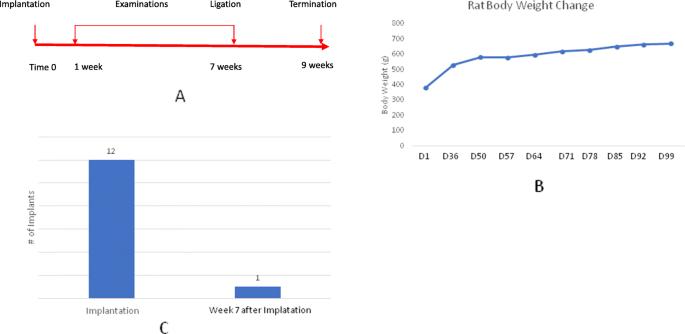Implant, Diastema, Rat, Micro-CT
Fig. 1. a) Time course of the experiment. b) Curve of the rat body weight change. c) Implant survival after 7 weeks of implantation. Implant success and failure rate is analyzed by using Clopper-Pearson’s exact method at 95% confidence interval. Our experiment data indicate that the true success rate of implantation in maxillary natural diastema in rat is less than 38.4% at a confident level of 95% : Is maxillary diastema an appropriate site for implant
author: Gang Yue, Husham Edani, Andrew Sullivan, Shuying Jiang, Hamed Kazerani, Mohammad Ali Saghiri | publisher: drg. Andreas Tjandra, Sp. Perio, FISID

Fig. 1. a) Time course of the experiment. b) Curve of the rat body weight change. c) Implant survival after 7 weeks of implantation. Implant success and failure rate is analyzed by using Clopper-Pearson’s exact method at 95% confidence interval. Our experiment data indicate that the true success rate of implantation in maxillary natural diastema in rat is less than 38.4% at a confident level of 95%
Serial posts:
- Abstract : Is maxillary diastema an appropriate site for implantation in rats?
- Highlights : Is maxillary diastema an appropriate site for implantation in rats?
- Background : Is maxillary diastema an appropriate site for implantation in rats? [1]
- Background : Is maxillary diastema an appropriate site for implantation in rats? [2]
- Materials and methods : Is maxillary diastema an appropriate site for implantation in rats? [1]
- Materials and methods : Is maxillary diastema an appropriate site for implantation in rats? [2]
- Results : Is maxillary diastema an appropriate site for implantation in rats?
- Discussion : Is maxillary diastema an appropriate site for implantation in rats? [1]
- Discussion : Is maxillary diastema an appropriate site for implantation in rats? [2]
- Discussion : Is maxillary diastema an appropriate site for implantation in rats? [3]
- Conclusion : Is maxillary diastema an appropriate site for implantation in rats?
- Availability of data and materials : Is maxillary diastema an appropriate site for implantation in rats?
- References : Is maxillary diastema an appropriate site for implantation in rats? [1]
- References : Is maxillary diastema an appropriate site for implantation in rats? [2]
- References : Is maxillary diastema an appropriate site for implantation in rats? [3]
- References : Is maxillary diastema an appropriate site for implantation in rats? [4]
- Acknowledgements : Is maxillary diastema an appropriate site for implantation in rats?
- Funding : Is maxillary diastema an appropriate site for implantation in rats?
- Author information : Is maxillary diastema an appropriate site for implantation in rats? [1]
- Author information : Is maxillary diastema an appropriate site for implantation in rats? [2]
- Ethics declarations : Is maxillary diastema an appropriate site for implantation in rats?
- Additional information : Is maxillary diastema an appropriate site for implantation in rats?
- Rights and permissions : Is maxillary diastema an appropriate site for implantation in rats?
- About this article : Is maxillary diastema an appropriate site for implantation in rats?
- Table 1 Rat body weight during the experiment : Is maxillary diastema an appropriate site for implantation in rats?
- Fig. 1. a) Time course of the experiment. b) Curve of the rat body weight change. c) Implant survival after 7 weeks of implantation. Implant success and failure rate is analyzed by using Clopper-Pearson’s exact method at 95% confidence interval. Our experiment data indicate that the true success rate of implantation in maxillary natural diastema in rat is less than 38.4% at a confident level of 95% : Is maxillary diastema an appropriate site for implant
- Fig. 2. Implantation of two implants at maxillary diastemata per rat. a Surgery implantation. b X-ray periapical picture after surgery. c Seven weeks after implantion : Is maxillary diastema an appropriate site for implant
- Fig. 3. a–c Micro-CT frontal planes indicate the location of implant. d, e Micro-CT sagittal plane. f, g Micro-CT transverse plane. h Micro-CT 3D constructed image indicates osseointegration around the implant fixture : Is maxillary diastema an appropriate site for implant
- Fig. 4. Micro-CT images indicate maxillary fist molar site will be able to provide a substantial cancellous bone to support a dental implant. a Sagittal plane. b Frontal plane : Is maxillary diastema an appropriate site for implant